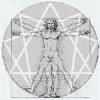BTG XXXIII <=> BTG XXV
XXIV. BEELZEBUB’S Flight to the Planet Earth for the Fifth Time (pgs. B315 – B346)
Chapitre 24 Belzébuth s’envole vers la planète Terre pour la cinquième fois
Capítulo 24 O voo de Belzebu para o planeta Terra pela quinta vez.
Beelzebub continued his tale telling Hassein that he visited Earth for the fifth time after the third catastrophe which was the cause of the destruction of their ‘centers of culture.’ This third catastrophe occurred as a result of ‘great winds,’ which lasted for several years and had as a result what was later called the ‘great migration of races.’
According to Beelzebub, as he observed the three-brained beings of the planet Earth, with the help of his teskooano on the planet Mars, trying to find out the exact cause of the chief particularity of their psyche, namely, their ‘periodic need to destroy the existence of beings like themselves,’ it flashed upon him that the length of their existence was, century by century, and even year by year, becoming shorter, at a very definite and uniform rate. So, he decided to go in person to the planet Earth, in order to clear up for himself on the spot the causes of this phenomenon. This time their ship Occasion alighted on what is now called the ‘Persian Gulf,’ which was convenient for his further travels because the large river on whose banks stood the city of Babylon flowed into it. Babylon was a ‘center of culture’ not only for the beings dwelling on the continent of Ashhark but also for the beings of all the other land masses. He tells Hassein as fully as possible what occurred during that period in Babylon, as all this information may serve him as a valuable material for helping to elucidate and transmute in his Reason all the causes that taken together have finally given rise to that psyche, so strange for three-centered beings, which his contemporary favorites now have. When they reached the city of Babylon, it was literally overflowing with ‘learned’ beings, who were gathered there from almost everywhere on the planet and they were all occupied with a question that would cause many of them to loose their Reason over it. Beelzebub recounts all the Babylonian events which had as a result for both the ‘sorry scientists’ and the ordinary beings of the city to be exceedingly anxious to know more about a ‘burning question;’ they wished to know whether or not they had a ‘soul.’
All sorts of fantastic theories about this question existed, and in spite of the number and variety of these theories, they were all based upon two quite opposite assumptions. One of these was called the ‘atheistic’ and the other the ‘idealistic,’ or ‘dualistic.’ In short, there was then taking place what is called the ‘building of the tower of Babel. He says that when he arrived in Babylon he began mingling with various beings and making corresponding observations in order to clear up the question that had interested him, that is, the shortening of their existence. Among the learned beings whom he often met for the sake of his aim was a certain Hamolinadir.
Hamolinadir was descended from the race of beings called ‘Assyrian,’ and his arising and preparation for becoming a responsible being had taken place in that very city of Babylon, his knowledge had been acquired in Egypt, in the highest school of all those existing on the Earth at that time, called the ‘School for Materializing Thought.’
Seven months after their arrival in the city of Babylon, Beelzebub went one day with his friend Hamolinadir to what is called a general scientific ‘conference.’ Hamolinadir had chosen to speak about the ‘instability of human Reason’ and after drawing a lot, it fell to him to speak fifth. After that speech which made such a deep impression upon the beings there, he left the city of Babylon for ever, and went to ‘Nineveh’ and existed somewhere there to a ripe old age. He never again occupied himself with ‘sciences’ and spent the rest of his existence in growing ‘choongary,’ which in contemporary language is called ‘maize.’ Certain of Hamolinadir’s expressions became ‘household sayings’ and some of them have even reached contemporary beings of the planet Earth-although misinterpreted. Among these is the ‘building of the Tower of Babel.’
As he explains to Hassein, the two teachings concerning the ‘question of the beyond,’ that had a large number of adherents were dispersed by the learned beings in their own countries. These two teachings passing from generation to generation began to confuse their ‘sane being-mentation.’ These notions finally and utterly destroyed the last remnants and even the traces of the results of the holly labors of the Very Saintly Ashiata Shiemash. In the name of justice he adds that the prime initiative for the destruction of the holy labors of Ashiata Shiemash did not spring from those learned terrestrial beings then assembled in the city of Babylon, but rather from the invention of a well-known ‘learned’ being that had existed in the continent of Asia several centuries before these Babylonian events. His name was Lentrohamsanin, and this being became one of those 313 Eternal Hasnamuss Individuals who now exist on the small planet bearing the name of ‘Retribution.’ He promises Hassein to tell him more about this man only after he has told him all about the Very Saintly Ashiata Shiemash and his activities in relation to this planet.

